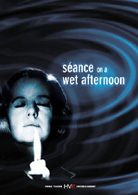Séance on a Wet Afternoon
| Bryan Forbes’ Séance on a Wet Afternoon is about a mentally unhinged woman who is so convinced she is a medium that she feels the need to construct an elaborate scheme to prove it to others, even though this scheme involves her faking the very powers of which she genuinely believes herself to be in possession. Of course, this is an irreconcilable paradox—after all, if she is really a medium, why would she have to feign her abilities?—but this never seems to occur to her. The film’s extraordinary power derives from the way in which actress Kim Stanley convinces us of this woman’s conviction, no matter how misguided and, ultimately, pathetic. Stanley, who passed away just this year, was a notable stage actress who ventured into film on only a few brief occasions. Her performance here as Myra Savage is probably her best known, as her eerie self-assurance and steely determination command the screen in a way that makes it impossible not to watch (she was nominated for an Oscar). However, as powerful as Stanley is, the film works largely because of the performance by Richard Attenborough (who also produced the film) as Bill Savage, Myra’s meek, mild-mannered husband who capitulates to his wife’s every demand, no matter how extraordinary or illegal. The power in Attenborough’s performance is the way in which he maintains our sympathy; his character is a sap, but one with an inner core of strength that gradually reveals itself throughout the film. One could even argue that the film is really about Bill and how he finally musters the strength to do what he knows is right, even if it goes against Myra’s wishes. The film’s tragedy is that it is his simultaneous salvation and damnation. Writer/director Bryan Forbes (The Stepford Wives), working from a novel by Mark McShane, begins the film in a deliberately obtuse manner, giving us scenes in which Myra and Bill plot their scheme, but without any guiding context as to what exactly they are doing. There are references to someone named Arthur, who Myra claims is her contact to the other world during seances, and we get the idea that this is a dead child, although when he died and under what circumstances is left vague until the end. This deliberate initial confusion allows the plot to grow slowly from the interchanges between the two characters, during which time we also learn the power dynamics of their relationship, which mostly involves Bill making lame attempts to assert himself before quietly submitting to Myra. At one point in a conversation, she turns off a record player and seconds later accuses Bill of having done it. Bill tries to point out that it was she who did it, but he quickly gives in and resigns himself to yet another, “Yes, dear.” The scheme they hatch is horrible, but Myra talks about it in such a calm, upbeat manner that you would think they were planning a weekend getaway to the beach. To prove to the rest of the world that she is a genuine medium, Myra convinces Bill to kidnap the child (Judith Donner) of a wealthy couple (Mark Eden and Nanette Newman). Having made up one of the upstairs bedrooms in their rambling, overstuffed Victorian house to look like a hospital room, they convince the child that she has been temporarily institutionalized while Myra ingratiates herself with the family by giving them “insight” as to their daughter’s whereabouts. It’s a sick plan, but because we are firmly rooted at all times in the Savages’ world, we see it largely through their eyes. For Myra, it is a beautiful plan that will help her in spreading the “truth” about herself. In fact, she doesn’t even refer to it as kidnapping, but rather says that she is “borrowing” a child. For Bill, it is a duty, something that has to be done because Myra wants it. He has his doubts from the very beginning, and those doubts grow steadily, gnawing at his insides and sparking that inner core of resistance. Made in the early 1960s in England, Séance on a Wet Afternoon has the spare, realist look of the so-called “kitchen-sink” films that were popular at that time. Eschewing the showy aesthetics that often characterize thrillers, Forbes and cinematographer Gerry Turpin (Oh! What a Lovely War) opt instead for a simpler, more direct visual approach that emphasizes the black-and-white realism of the story. Of course, it is tinged with elements of the supernatural. Even though Myra is, in effect, a fraud, there are subtle hints here and there that she does possess some kind of power, and one gets the idea that she simply wants more. Whatever psychic gifts she has are not enough to satisfy her need for importance. Her eyes literally dance when she talks of how people will learn the truth about her, but it is a dance of barely concealed insanity. Subdued as she is, Myra is no less terrifying that any horror movie monster, although that terror is thoroughly intertwined with a palpable sadness that makes her, against all odds, sympathetic. Almost forgotten in the years since its release, Séance on a Wet Afternoon is a small gem of a thriller, one told from the inside out without any sense of being hurried. It burns long and slow (perhaps too slow for some), but the way it draws you into the world of its characters and makes you see the story unfolding through their eyes creates a moving tension all its own.
Copyright © 2002 James Kendrick | |||||||||||||||||||||||||||||||||||||||||

